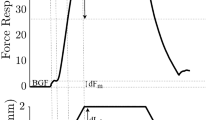Summary
Muscle activation patterns of the quadriceps and hamstrings were studied in normal human subjects walking at comfortable speed on a treadmill. In addition knee angular velocity patterns and swing and stance phases of the step cycle were recorded. Data were collected from normal paces and from paces in which a momentary unexpected resistance was applied to the leg during swing.
The application of the resistance caused an advance in the onset of both quadriceps and hamstrings activity. The latency of the onset of activity following the resistance in the quadriceps was 78.2±26.4 ms and this was considered to indicate a long latency stretch reflex. There was a close association between the onset of quadriceps and hamstrings activity both in the normal and resistance paces. The changes observed in knee angular velocity upon application of the resistance indicate tight control of angular velocity patterns. The results have important implications regarding neural control of muscle during purposive movement and the regulation of sensitivity of muscle receptors during such movements, especially during the periods when the muscle is normally inactive.
Similar content being viewed by others
References
Battye CK, Joseph J (1966) An investigation by telemetering of the activity of some muscles in walking. Med Biol Eng 4: 123–135
Boyd IA (1980) The isolated mammalian muscle spindle. Trends Neurosci 3: 258–264
Burke D, Hagbarth KE, Skuse NF (1979) Voluntary activation of spindle endings in human muscles temporarily paralysed by nerve pressure. J Physiol (Lond) 287: 329–336
Burke D (1980) Muscle spindle function during movement. Trends Neurosci 3: 251–253
Cavanagh PR, Gregor RJ (1975) Knee joint torque during the swing phase of normal treadmill walking. J Biomech 8: 337–344
Chan CWY, Melvill Jones G, Kearney RE, Watt DGD (1979) The “late” electro-myographic response to limb displacement in man, 1. Evidence for supraspinal contribution. Electroencephalogr Clin Neurophysiol 46: 178–181
Desmedt JE (1978) (ed) Cerebral motor control in man: long loop mechanisms. Progress in clinical neurophysiology, vol 4. Karger, Basel
Engberg I, Lundberg A (1969) An electromyographic analysis of muscular activity in the hind limb of the cat during unrestrained locomotion. Acta Physiol Scand 75: 614–630
Garrett M, Atha J (1977) The role of the servo-loop in the swing phase of walking in man. Ir J med Sci 146: 308
Garrett M, Luckwill RG, McAleer JJA (1981) The sensitivity of the monosynaptic reflex arc in the leg extensor muscles of the walking man. In: Morecki A et al (eds) International series on Biomechanics, vol 3A. University Park Press, Baltimore, pp 95–99
Granit R (1955) Receptors and sensory perception. Yale University Press, New Haven
Grillner S, Rossignol S (1978) On the initiation of the swing phase of locomotion in chronic spinal cats. Brain Res 146: 269–277
Hagbarth KE (1981) Fusimotor and stretch reflex functions studied in recordings from muscle spindle afferents in man. In: Taylor A, Prochazka A (eds) Muscle spindle receptors and movement. MacMillan, London, pp 277–285
Hammond PM (1960) An experimental study of servo action in human muscular control. Proc 3rd Int Cong Med Electron, Lond, pp 190–199
Johnson SW, Lynn PA, Miller JSG, Reed GAL (1977) Miniature skin-mounted pre-amplifier for measurement of surface electromyographic potentials. Med Biol Eng Comput 15: 710–711
Johnston RC, Smidt GL (1969) Measurement of hip joint motion during walking. J Bone Joint Surg [Am] 51: 1083–1094
Liddell EG, Sherrington CS (1924) Reflexes in response to stretch. Proc R Soc Lond 96: 212–242
Loeb GE (1981) Somatosensory unit input to the spinal cord during normal walking. Can J Physiol Pharmacol 59: 627–635
Lundberg A (1969) Reflex control of stepping. The Nansen memorial lecture V. Universitetsforlaget, Oslo
Maillardet FJ (1977) The swing phase of walking. Eng Med 6: 67–75 & 101–106
Marsden CD, Merton PA, Morton HB (1973) Is the human stretch reflex cortical rather than spinal. Lancet I: 759–661
Marsden CD, Merton PA, Morton HB (1976) Stretch reflex and servo action in a variety of human muscles. J Physiol (Lond) 259: 531–560
Matthews PBC (1972) Mammalian muscle receptors and their central actions. Arnold, London, pp 572–574
Melzack R, Wall PD (1965) Pain mechanisms: a new theory. Science 150: 971–999
Milner M, Basmajian JV, Quanbury AO (1971) Multi factorial analysis of walking by electromyography and computer. Am J Phys Med 50: 235–257
Mitchelson D (1975) Recording movement without photography. In: Grieve et al (eds) Techniques for the analysis of human movement. Lepus Books, London, pp 37–68
Mongia SK (1972) H reflex from quadriceps and gastrocnemius muscles. Electromyogr Clin Neurophysiol 12: 179–190
Prochazka A, Wand P (1981) Independence of fusimotor and skeletomotor systems during voluntary movement. In: Taylor A, Prochazka A (eds) Muscle receptors and movement. MacMillan London, pp 229–243
Prochazka A, Westerman RA, Ziccone SP (1976) Discharges of single hindlimb afferents in the freely moving cat. J Neurophysiol 39: 1090–1104
Vallbo AB (1981) Basic patterns of muscle spindle discharge in man. In: Taylor A, Prochazka A (eds) Muscle receptors and movement. MacMillan, London, pp 263–275
Author information
Authors and Affiliations
Additional information
Supported in part by grant from the Medical Research Council of Ireland
Rights and permissions
About this article
Cite this article
Garrett, M., Luckwill, R.G. Role of reflex responses of knee musculature during the swing phase of walking in man. Europ. J. Appl. Physiol. 52, 36–41 (1983). https://doi.org/10.1007/BF00429022
Accepted:
Issue Date:
DOI: https://doi.org/10.1007/BF00429022




